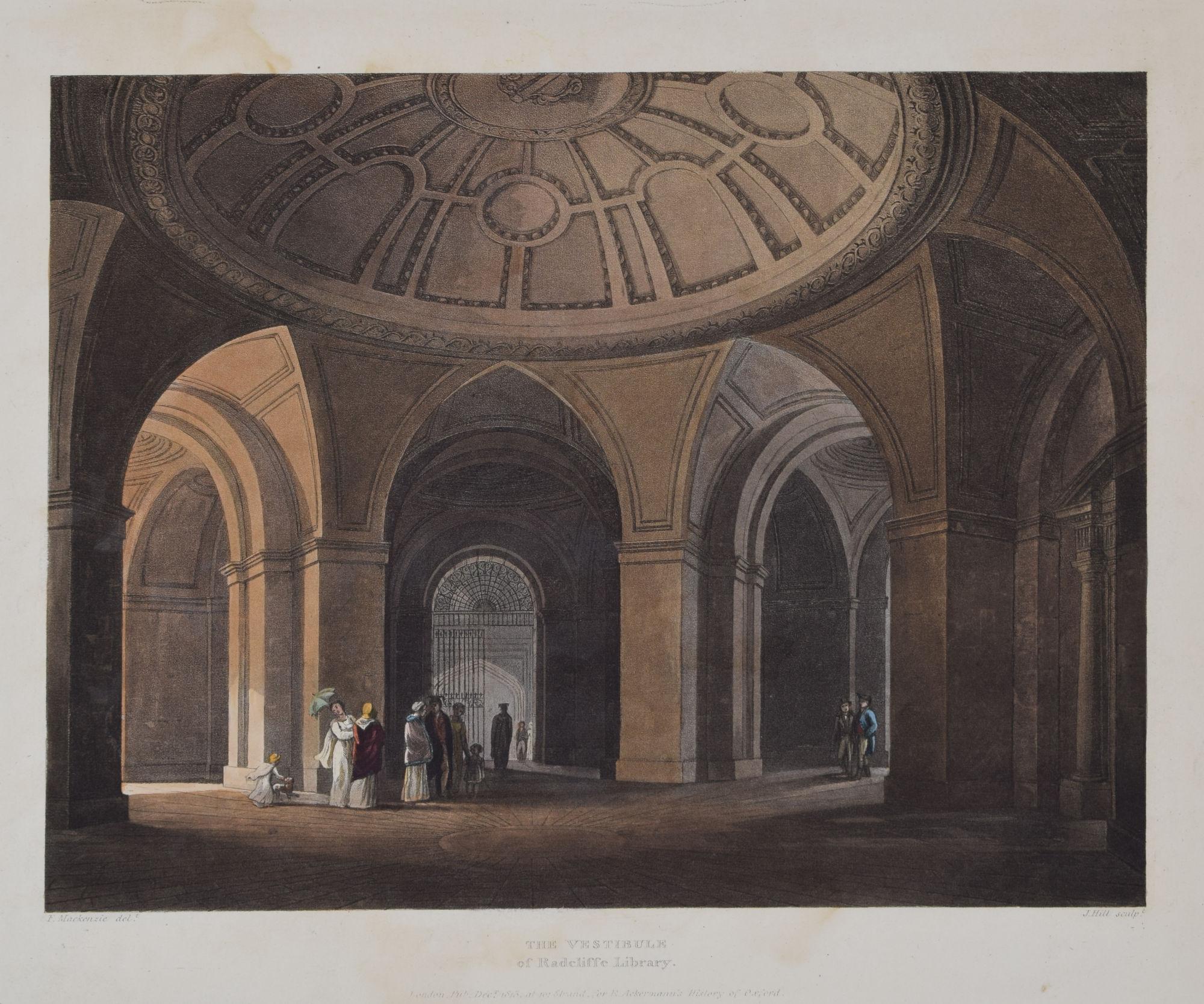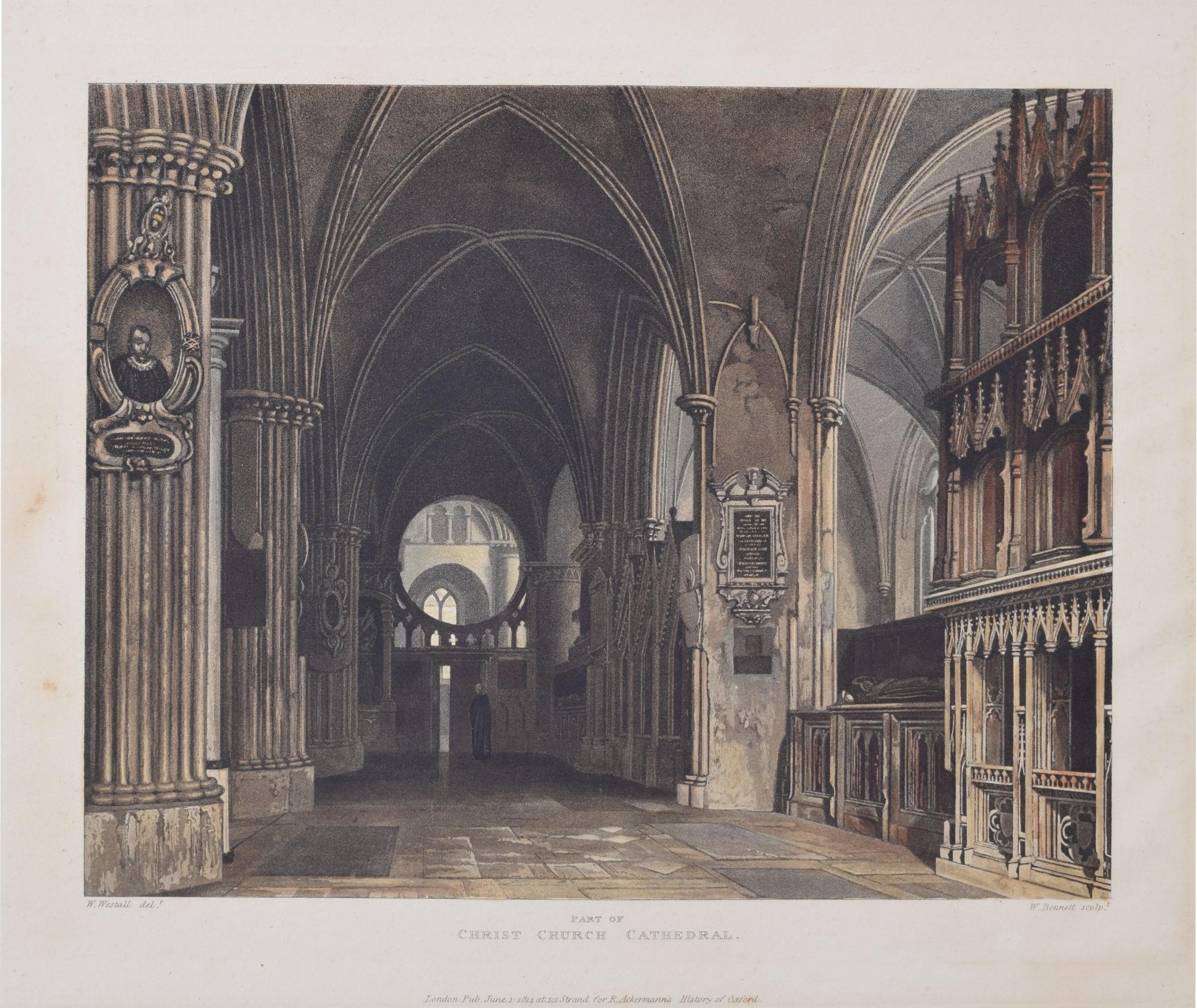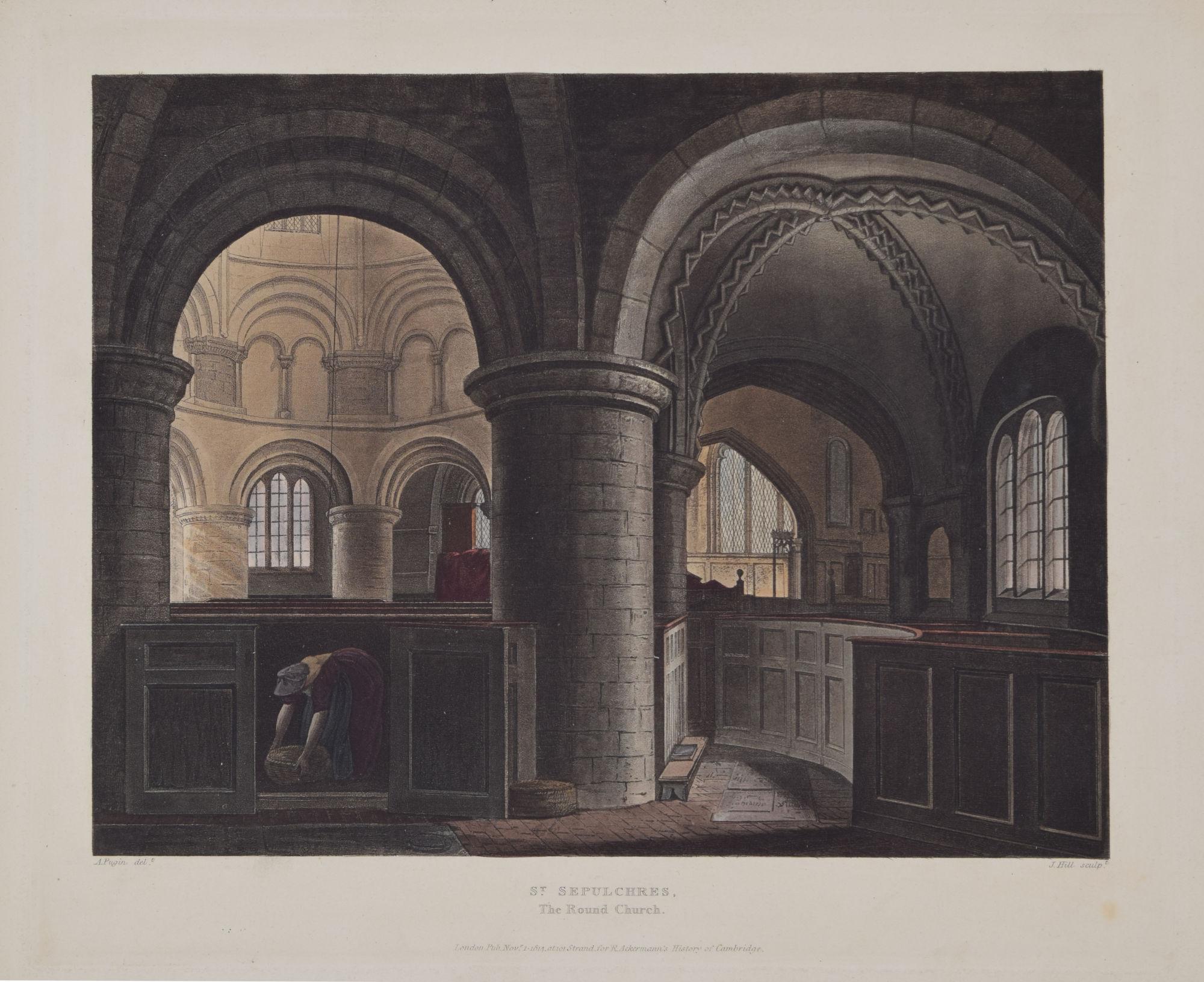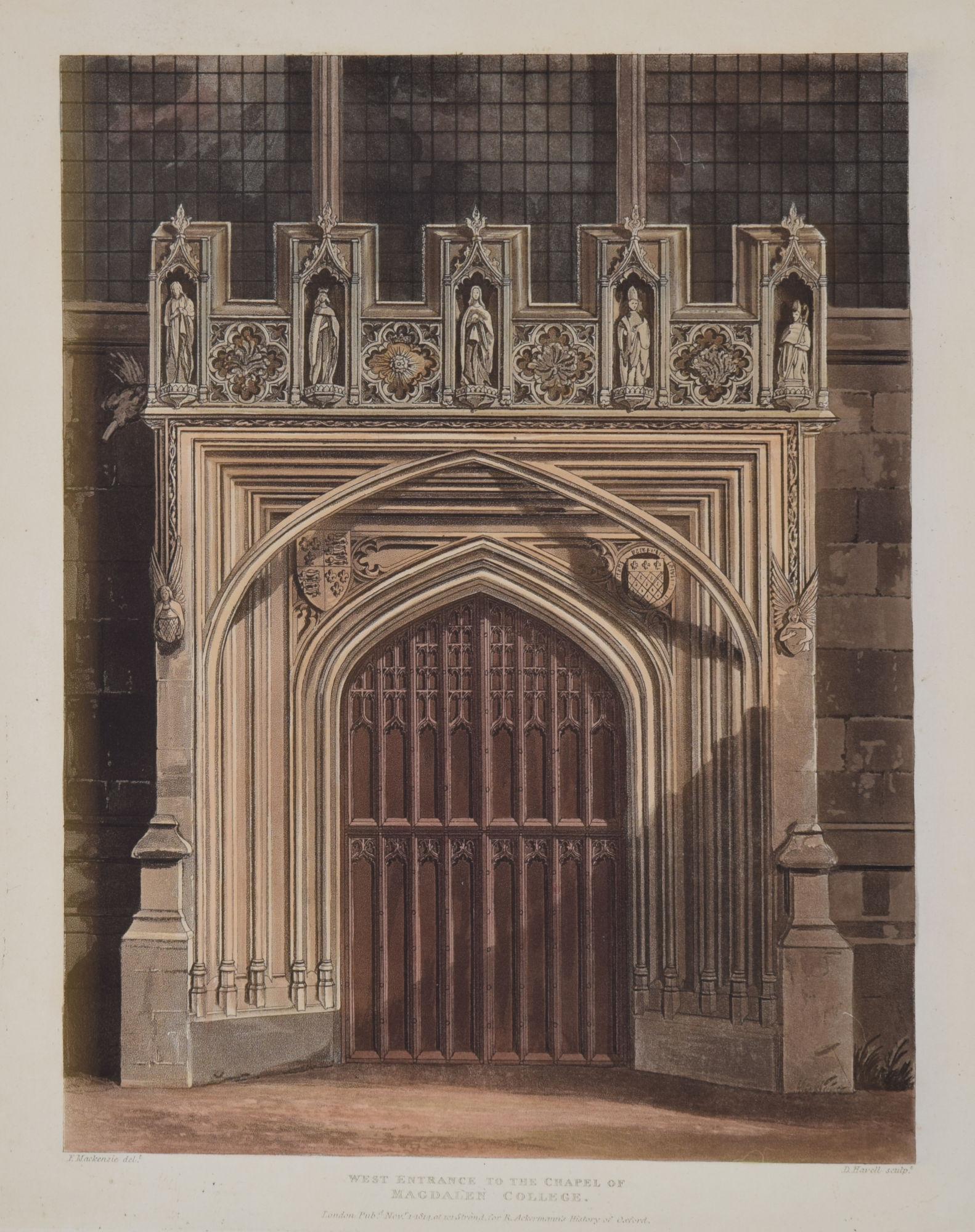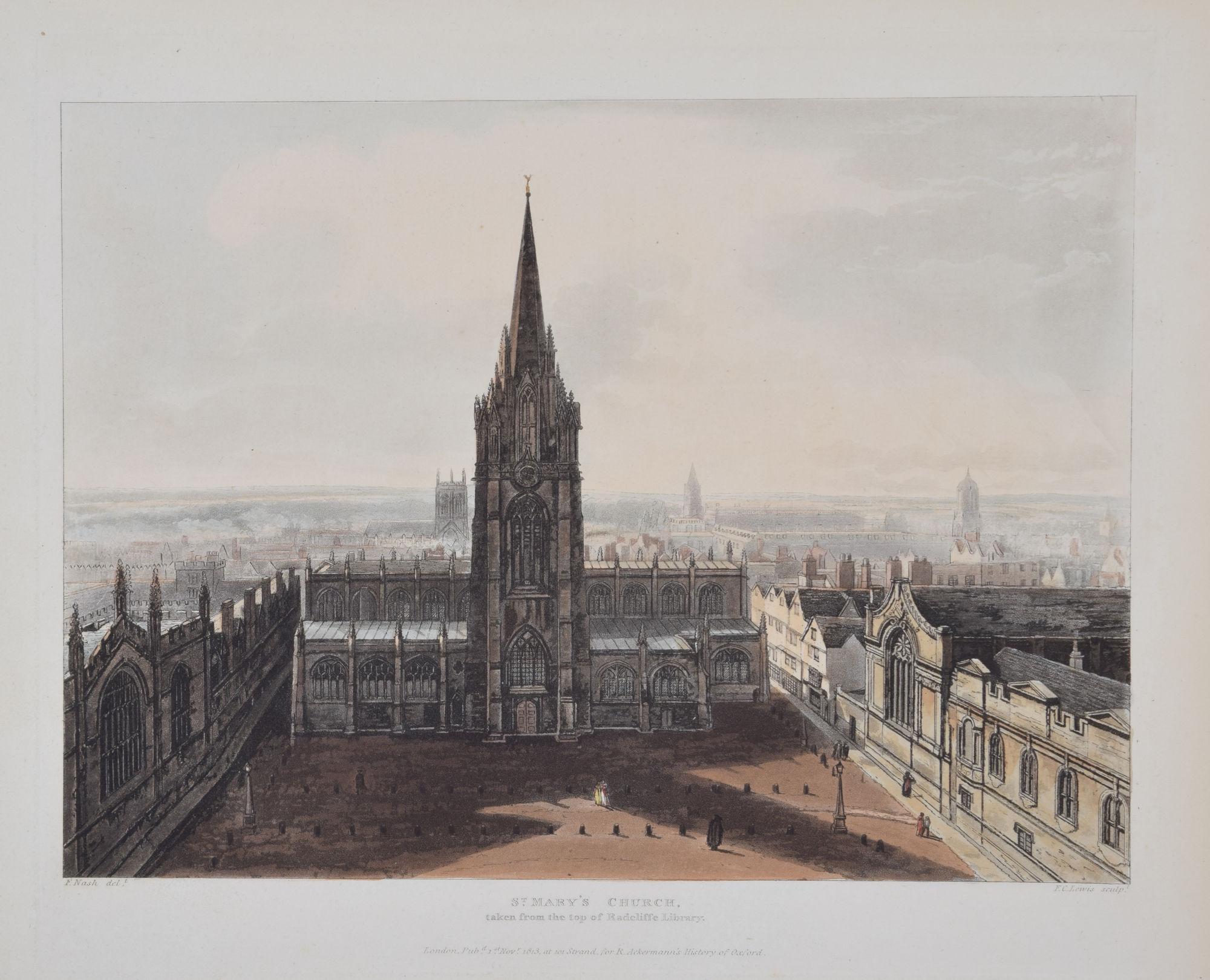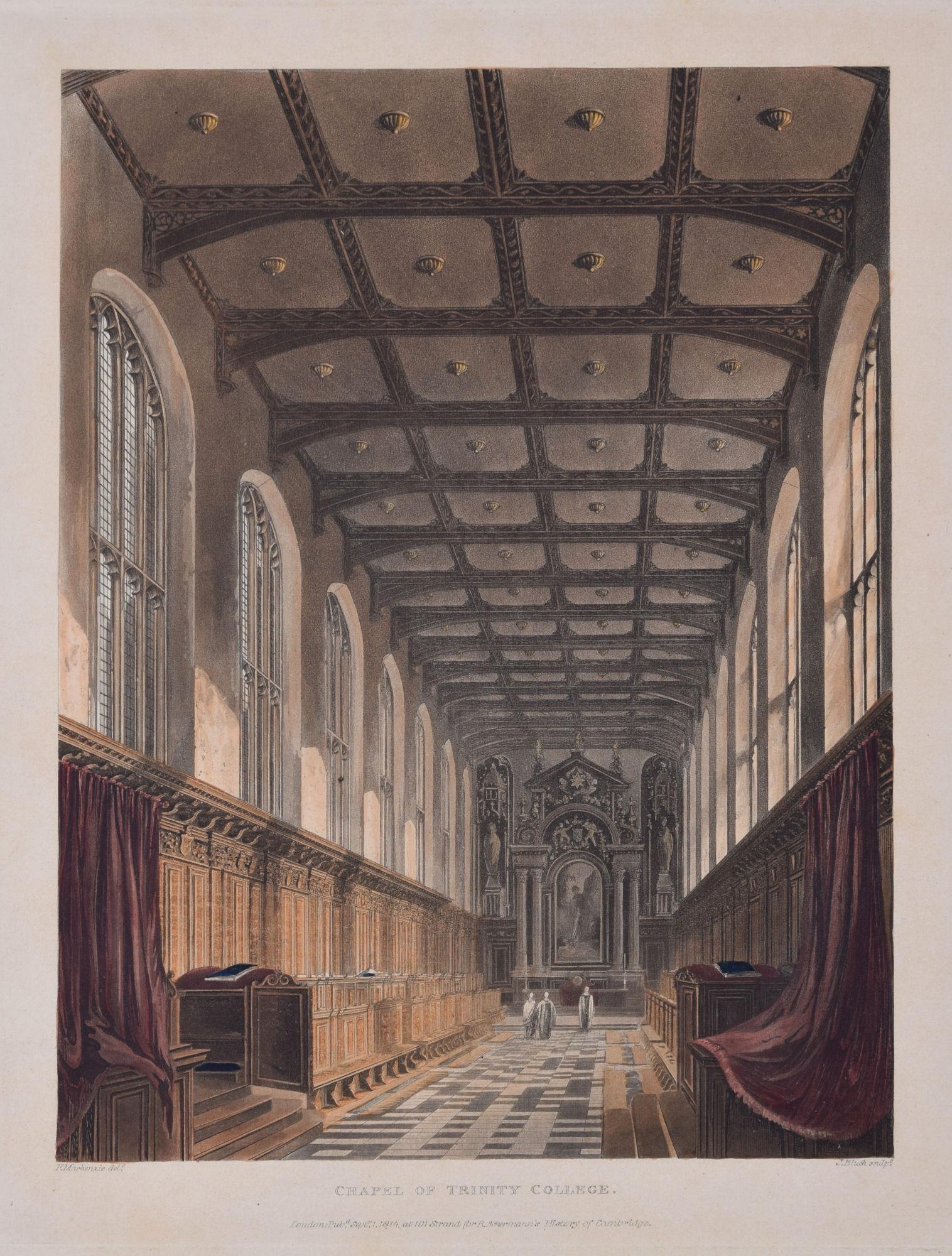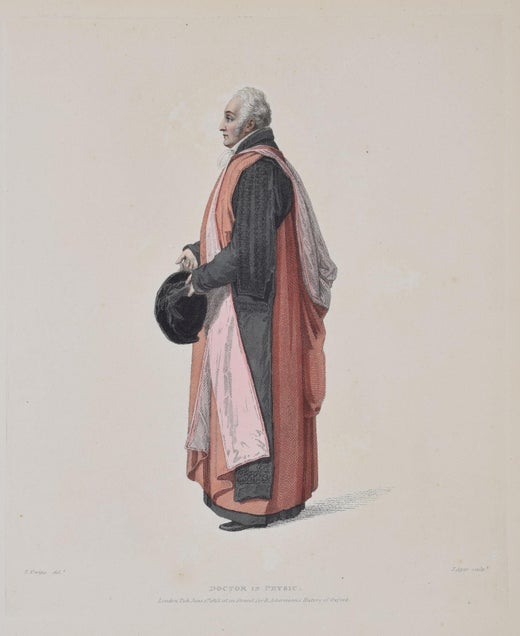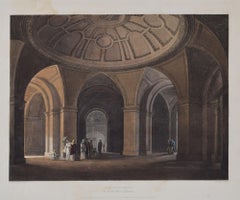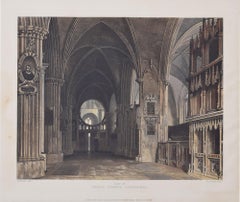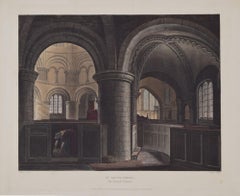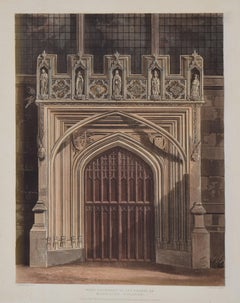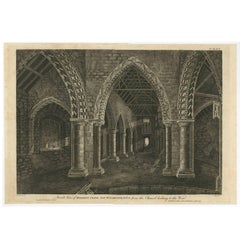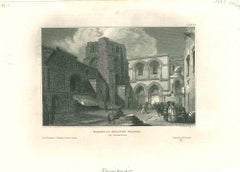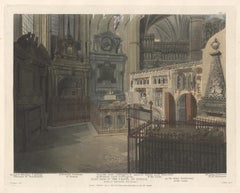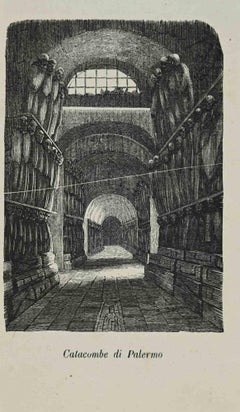Items Similar to Crypt of St Peter's Church, Oxford engraving by Bluck after Nash for Ackermann
Want more images or videos?
Request additional images or videos from the seller
1 of 6
Rudolph AckermannCrypt of St Peter's Church, Oxford engraving by Bluck after Nash for Ackermann1813
1813
$379.12
£275
€321.13
CA$524.20
A$575.50
CHF 300.24
MX$6,964.40
NOK 3,763.07
SEK 3,545.80
DKK 2,397.15
About the Item
To see our other Oxford and Cambridge pictures, including an extensive collection of works by Ackermann, scroll down to "More from this Seller" and below it click on "See all from this Seller" - or send us a message if you cannot find the view you want.
John Bluck (early 19th century) after Frederick Nash (1782 - 1856)
Crypt of St Peter's Church, Oxford (1813)
Aquatint with original hand colouring
21 x 27 cm
Published by Rudolph Ackermann (1764 - 1834).
Frederick Nash was born in Lambeth. He studied architectural drawing under Thomas Malton and then enrolled at the Royal Academy of Arts. From 1801 to 1809 he worked with the antiquarians John Britton and Edward Wedlake Brayley, subsequently becoming a member of the Society of Painters in Watercolours - a group of painters who had left the Royal Academy following complaints of under-recognition of their works. Nash became primarily a landscape painter and toured the rivers of Germany.
John Bluck was an aquatint engraver, mainly of topographical views, but also of marine and sporting subjects after his contemporaries. He produced plates for numerous publications.
Rudolph Ackermann was an Anglo-German bookseller, inventor, lithographer, publisher and businessman. In 1795 he established a print-shop and drawing-school at 96 Strand. Here Ackermann set up a lithographic press and began a trade in prints. He later began to manufacture colours and thick carton paper for landscape and miniature painters. Within three years the premises had become too small and he moved to 101 Strand, in his own words "four doors nearer to Somerset House", the seat of the Royal Academy of Arts. Between 1797 and 1800 Ackermann rapidly developed his print and book publishing business, encompassing many different genres including topography, caricature, portraits, transparencies and decorative prints.
- Creator:Rudolph Ackermann (1764 - 1834)
- Creation Year:1813
- Dimensions:Height: 8.27 in (21 cm)Width: 10.63 in (27 cm)
- Medium:
- Period:
- Framing:Framing Options Available
- Condition:Generally very good; trimmed close to platemark at bottom.
- Gallery Location:London, GB
- Reference Number:1stDibs: LU795315046742
Rudolph Ackermann was an Anglo-German bookseller, inventor, lithographer, publisher and businessman. In 1795 he established a print-shop and drawing-school at 96 Strand. Here Ackermann set up a lithographic press and began a trade in prints. He later began to manufacture colours and thick carton paper for landscape and miniature painters. Within three years the premises had become too small and he moved to 101 Strand, in his own words "four doors nearer to Somerset House", the seat of the Royal Academy of Arts. Between 1797 and 1800 Ackermann rapidly developed his print and book publishing business, encompassing many different genres including topography, caricature, portraits, transparencies, and decorative prints.
About the Seller
4.8
Vetted Professional Seller
Every seller passes strict standards for authenticity and reliability
Established in 2014
1stDibs seller since 2017
359 sales on 1stDibs
Typical response time: 6 hours
- ShippingRetrieving quote...Shipping from: London, United Kingdom
- Return Policy
Authenticity Guarantee
In the unlikely event there’s an issue with an item’s authenticity, contact us within 1 year for a full refund. DetailsMoney-Back Guarantee
If your item is not as described, is damaged in transit, or does not arrive, contact us within 7 days for a full refund. Details24-Hour Cancellation
You have a 24-hour grace period in which to reconsider your purchase, with no questions asked.Vetted Professional Sellers
Our world-class sellers must adhere to strict standards for service and quality, maintaining the integrity of our listings.Price-Match Guarantee
If you find that a seller listed the same item for a lower price elsewhere, we’ll match it.Trusted Global Delivery
Our best-in-class carrier network provides specialized shipping options worldwide, including custom delivery.More From This Seller
View AllRadcliffe Library, Oxford engraving by Hill after Mackenzie for Ackermann
Located in London, GB
To see our other Oxford and Cambridge pictures, including an extensive collection of works by Ackermann, scroll down to "More from this Seller" and below it click on "See all from th...
Category
1810s Realist Prints and Multiples
Materials
Aquatint
Christ Church Cathedral, Oxford interior engraving by Bennett after Westall
Located in London, GB
To see our other Oxford and Cambridge pictures, including an extensive collection of works by Ackermann, scroll down to "More from this Seller" and below it click on "See all from th...
Category
1810s Realist Prints and Multiples
Materials
Engraving, Aquatint
St Sepulchre, The Round Church, Cambridge interior after Pugin for Ackermann
Located in London, GB
To see our other Oxford and Cambridge pictures, including an extensive collection of works by Ackermann, scroll down to "More from this Seller" and below it click on "See all from this Seller" - or send us a message if you cannot find the view you want.
John Hill (1770 - 1850) after Augustus Charles Pugin (1762 - 1832)
St Sepulchre's - The Round Church (1814)
Aquatint with original hand colouring
24 x 29 cm
Published by Rudolph Ackermann (1764 - 1834).
An interior engraving of the Church of the Holy Sepulchre, Cambridge, the round shape of which is inspired by the rotunda in the church of the Holy Sepulchre, Jerusalem.
John Hill was born in London in 1770, and was an engraver's apprentice. He worked in aquatint and largely produced book illustration aquatints. He went to America in 1816 and produced the notable Picturesque Views of American Scenery amongst other books of prints.
Augustus Charles Pugin was an Anglo-French artist and architectural draughtsman. Pugin produced views of London, jointly creating the illustrations for the 'Microcosm of London' published by Rudolph Ackermann in 1811, followed by plates for Ackermann's books about Westminster Abbey, Oxford and Cambridge universities, and Winchester College. His later works included illustrations for Specimens of Gothic Architecture (1821–1823), The Royal Pavilion at Brighton (1826), Architectural Antiquities of Great Britain (1826), Specimens of the Architectural Antiquities of Normandy (1827), Illustrations of the Public Buildings of London (1825 to 1828), Paris and its Environs (1829 to 1831), and Examples of Gothic Architecture (1831). He also produced a book of furniture designs called Gothic Furniture, and assisted architects with detailing for their gothic designs. He ran a drawing school at his house in Bloomsbury.
Ackermann was an Anglo-German bookseller, inventor, lithographer, publisher and businessman. He attended the Latin school in Stollberg, but his wish to study at the university was made impossible by lack of financial means, and he therefore became a saddler like his father.
He worked as a saddler and coach-builder in different German cities, moved from Dresden to Basel and Paris, and then, 23 years old, settled in London. He established himself in Long Acre, the centre of coach-making in London and close to the market at Covent Garden.
Ackermann then moved to Little Russell Street where he published Imitations of Drawings of Fashionable Carriages (1791) to promote his coach-making. Other publications followed. In 1795 he established a print-shop and drawing-school at 96 Strand. Here Ackermann set up a lithographic press and began a trade in prints. He later began to manufacture colours and thick carton paper for landscape and miniature painters. Within three years the premises had become too small and he moved to 101 Strand, in his own words "four doors nearer to Somerset House", the seat of the Royal Academy of Arts.
Between 1797 and 1800 Ackermann rapidly developed his print and book publishing business, encompassing many different genres including topography, caricature, portraits, transparencies and decorative prints.
During the Napoleonic wars, Ackermann was an energetic supporter of the Allied cause and made significant contributions to British propaganda through his publication of anti-Napoleonic prints...
Category
1810s Prints and Multiples
Materials
Aquatint
Chapel of Magdalen College, Oxford engraving by Havell for Ackermann
Located in London, GB
To see our other Oxford and Cambridge pictures, including an extensive collection of works by Ackermann, scroll down to "More from this Seller" and below it click on "See all from th...
Category
1810s Realist Prints and Multiples
Materials
Aquatint
St Mary's Church, Oxford engraving by Lewis after Nash for Ackermann
Located in London, GB
To see our other Oxford and Cambridge pictures, including an extensive collection of works by Ackermann, scroll down to "More from this Seller" and below it click on "See all from this Seller" - or send us a message if you cannot find the view you want.
Frederick Christian Lewis (1779 - 1856) after Frederick Nash (1782 - 1856)
St Mary's Church, Oxford (1813)
Aquatint with original hand colouring
21 x 27 cm
Published by Rudolph Ackermann (1764 - 1834).
Frederick Nash was born in Lambeth. He studied architectural drawing under Thomas Malton and then enrolled at the Royal Academy of Arts. From 1801 to 1809 he worked with the antiquarians John Britton and Edward Wedlake Brayley, subsequently becoming a member of the Society of Painters in Watercolours - a group of painters who had left the Royal Academy following complaints of under-recognition of their works. Nash became primarily a landscape painter and toured the rivers of Germany.
Frederick Christian Lewis was an English etcher, aquatint and stipple engraver, landscape and portrait painter. He studied under J. C. Stadler and in the schools of the Royal Academy and aquatinted most of Thomas Girtin's etchings of Paris...
Category
1810s Prints and Multiples
Materials
Aquatint
Chapel of Trinity College, Cambridge engraving by John Bluck for Ackermann
Located in London, GB
To see our other Oxford and Cambridge pictures, including an extensive collection of works by Ackermann, scroll down to "More from this Seller" and below it click on "See all from th...
Category
1810s Realist Prints and Multiples
Materials
Aquatint
You May Also Like
Antique Print with Inside View of Magdalen Chapel, Winchester, Hampshire, 1790
Located in Langweer, NL
An antique line engraving by J. Basire after J. Schnebbelie, published in 1790. The Magdalen Chapel is located in the Cowgate in Edinburgh. The Chapel was built between 1541 and 1544 by Janet Rynd, widow of Michael MacQueen (died 1537), who had left money for this purpose. The building was to be the new chapel for the Incorporation of Hammermen and was to include accommodation for a chaplain and also an almshouse for seven Bedesmen (poor men) ‘who should continually pour forth prayers to Almighty God’.
Category
Antique Late 18th Century Prints
Materials
Paper
$158 Sale Price
20% Off
The Church of the Holy Grave - Original Lithograph - Mid-19th Century
Located in Roma, IT
Ancient View of the Church of the Holy Grave is an original modern artwork realized in the mid 19th Century.
Original B/W Lithograph on Ivory Paper.
Ins...
Category
Early 19th Century Figurative Prints
Materials
Paper, Lithograph
East Side of the Chapel of St Paul, Westminster Abbey, architecture aquatint
By John Bluck (active 1791-1819) after Frederick Mackenzie (1788-1854)
Located in Melbourne, Victoria
'East Side of the Chapel of St Paul'
Colour aquatint by John Bluck (active 1791-1819) after Frederick Mackenzie (1788-1854).
Architectural interior with superb original colour. Fro...
Category
Early 19th Century Naturalistic Landscape Prints
Materials
Engraving, Etching, Aquatint
Catacombs of Palermo - Lithograph - 1862
Located in Roma, IT
Catacombs of Palermo is a lithograph realized in 1862.
Good conditions.
The artwork belongs to the Suite Uses and customs of all the peoples of the universe, or History of the gov...
Category
1840s Modern Figurative Prints
Materials
Lithograph
West Side of the Chapel of St Paul, Westminster Abbey, architecture aquatint
By John Bluck (active 1791-1819) after Frederick Mackenzie (1788-1854)
Located in Melbourne, Victoria
Colour aquatint by John Bluck (active 1791-1819) after Frederick Mackenzie (1788-1854).
Architectural interior with superb original colour. From 'Westminster Abbey', published by Ru...
Category
Early 19th Century Naturalistic Landscape Prints
Materials
Engraving, Etching, Aquatint
Inside View of Magdalen Chapel – Engraving of Medieval Gothic Interior, 1790
Located in Langweer, NL
Inside View of Magdalen Chapel – Engraving of Medieval Gothic Interior, 1790
This atmospheric antique engraving captures the interior of the Magdalen Chapel near Winchester, as view...
Category
Antique 18th Century English Prints
Materials
Paper
More Ways To Browse
Royal Academy Of Arts
Twa Vintage Print
Vintage Political Posters
Vintage Poster Washington
Winter Scene Prints
Agostino Tofanelli
Al Hirschfeld Etching
Alex Katz Woodcut
Altman Artist
Andy Warhol Exhibition Poster
Antique Farm Prints
Antonio Saura
Astronomy Print
Banksy Poster
Bonjour Vintage
Boulanger Lithograph
British Linocuts
By Mark Drew
